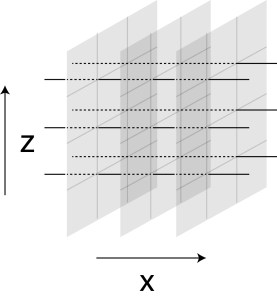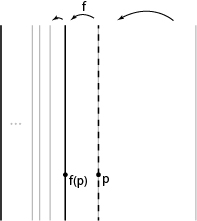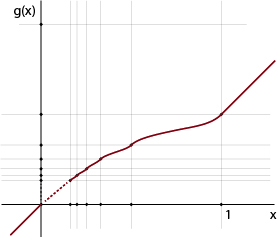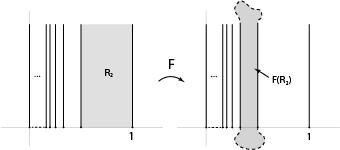I remember looking at Gromov’s notes “Carnot-Carathéodory spaces seen from within” a long time ago and didn’t get anywhere. Recently I encountered it again through professor Guth. This time, with his effort in explaining, I did get some ideas. This thing is indeed pretty cool~ So I decided to write an elementary introduction about it here. We will construct a such metric in .
In general, if we have a Riemannian manifold, the Riemannian distance between two given points is defined as
where is the collection of all differentiable curves
connecting the two points.
However, if we have a lower dimensional sub-bundle of the tangent bundle (depending continuously on the base point). We may attempt to define the metric
where is the collection of curves connecting
with
for all
. (i.e. we are only allowed to go along directions in the sub-bundle.
Now if we attempt to do this in , the first thing we may try is let the sub-bundle be the say,
-plane at all points. It’s easy to realize that now we are ‘stuck’ in the same height: any two points with different
coordinate will have no curve connecting them (hence the distance is infinite). The resulting metric space is real number many discrete copies of
. Of course that’s no longer homeomorphic to
.
Hence for the metric to be finite, we have to require accessibility of the sub-bundle: Any point is connected to any other point by a curve with derivatives in the .
For the metric to be equivalent to our original Riemannian metric (meaning generate the same topology), we need to be locally accessible: Any point less than
away from the original point
can be connected to
by a curve of length
going along
.
At the first glance the existence of a (non-trivial) such metric may not seem obvious. Let’s construct one on that generates the same topology:
To start, we first identify our with the
real entry Heisenberg group
(all
upper triangular matrices with “1”s on the diagonal). i.e. we have homeomorphism
Let be a left-invariant metric on
.
In the Lie algebra (tangent space of the identity element), the elements
and
form a basis.
At each point, we take the two dimensional sub-bundle of the tangent bundle generated by infinitesimal left translations by
. Since the metric
is left invariant, we are free to restrict the metric to
i.e. we have
for each
.
The interesting thing about is that all points are accessible from the origin via curves everywhere tangent to
. In other words, any points can be obtained by left translating any other point by multiples of elements
and
.
The “unit grid” in under this sub-Riemannian metric looks something like:
Since we have
,
the original -direction stay the same, i.e. a bunch of horizontal lines connecting the original
planes orthogonally.
However, if we look at a translation by , we have
i.e. a unit length -vector not only add a
to the
-direction but also adds a height
to
, hence the grid of unit
vectors in the above three
planes look like:
We can now try to see the rough shape of balls by only allowing ourselves to go along the unit grid formed by and
lines constructed above. This corresponds to accessing all matrices with integer entry by words in
and
.
The first question to ask is perhaps how to go from to
. –since going along the
axis is disabled. Observe that going through the following loop works:
We conclude that in fact up to a constant going along such loop gives the actual distance.
At this point one might feel that going along axis in the C-C metric is always takes longer than the ordinary distance. Giving it a bit more thought, we will find this is NOT the case: Imagine what happens if we want to go from
to
?
One way to do this is to go along for 100 steps, then along
for 100 steps (at this point each step in
will raise
in
-coordinate, then
. This gives
.
To illustrate, let’s first see the loop from to
:
The loop has length . (A lot shorter compare to length
for going
unit in
-direction)
i.e. for large , it’s much more efficient to travel in the C-C metric.
In fact, we can see the ball of radius is roughly an rectangle with dimension
(meaning bounded from both inside and outside with a constant factor). Hence the volume of balls grow like
.
Balls are very “flat” when they are small and very “long” when they are large.














